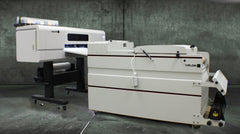This is a question asked every day on social media, "Why is my printer acting weird when I try and print a gang sheet." Or, "I printed all day yesterday, but today the computer just sits there processing the images, what to do?" Is it the printer?
Most of the time it has to do with the computer, computer set up, or user-error (hate to say it, but it's true) Let's do a quick overview of what could be your frustrations with your "printer".
First, let’s review RIP Software and what it does for your printer?
RIP (Raster Image Processor) software for printers serves several crucial functions:
-
Color Management: It optimizes color accuracy and consistency across different devices and materials, ensuring that the printed output represents the digital design as closely as possible. That’s right we used the word "Represents" because people see the word match and they think that their CMYK printer is going to be able to color match their computer screen, or match a PMS color...all you can do with CMYK printers is get a close representation! (we could go on and on,...maybe another day)
-
Image Processing: It converts digital images into a format that can be understood by the printer, handling tasks like color separations, halftoning, and image scaling.
-
Printer Control: It manages the printing process, including communication with the printer hardware, controlling ink or toner deposition, and ensuring proper alignment and registration of colors. (Registration of colors, another big topic that we will dive into another day)
-
Workflow Automation: It streamlines printing workflows by automating repetitive tasks, such as batch processing, imposition, and job queuing, which can improve productivity and reduce errors.
-
Advanced Features: Some RIP software offers additional features like nesting (optimizing layout for minimal material waste), variable data printing (customizing each print with unique data), and outside the DTF world it could be some specialty effects (such as spot varnishes).
Overall, RIP software plays a crucial role in maximizing the quality, efficiency, and versatility of digital printing processes. So, before anything...learn your RIP software.
Ok, so let’s get to the heart of the matter, or let’s talk about “the elephant in the room”. Many DTF print shops have spent $2,000 to $50,000 on your DTF printer and then someone hooks up a 12 year old windows POS computer they had in school, and then try to run their business with that. We cannot stress this enough - DON'T GO CHEAP ON YOUR COMPUTER!
The optimum computer specifications for managing RIP software for printers will depend on the specific requirements of the software. But, we've put together some guidelines, for what to look for in your computer and printer pairing.
-
Processor (CPU): A multi-core processor (preferably quad-core or higher) with a high clock speed is recommended to handle the computational demands of image processing and printer control tasks efficiently. This could be a big reason why gang sheets are slowing you down!
-
Memory (RAM): A minimum of 8 GB of RAM is typically recommended for basic RIP software usage. However, for handling large or complex print jobs, especially those with high-resolution images or multiple layers, 16 GB or more of RAM may be beneficial to ensure smooth operation.
-
Graphics Card (GPU): While many RIP software packages primarily rely on CPU processing power, having a dedicated graphics card with GPU acceleration capabilities can enhance performance, especially for tasks involving complex image rendering or real-time previews.
-
Storage: Solid-state drives (SSDs) offer faster read and write speeds compared to traditional hard disk drives (HDDs), which can help reduce loading times and improve overall system responsiveness, especially when working with large image files.
-
Operating System: Most RIP software is compatible with Windows operating systems, so a Windows-based PC is typically recommended. However, some RIP solutions may also offer support for macOS or Linux, depending on the software vendor.
-
Network Connectivity: If the RIP software is being used in a networked printing environment, ensure that the computer has reliable Ethernet or Wi-Fi connectivity to communicate with the printers and other devices on the network. We recommend not having it on a network at all. Operate the printer in its own environment - guarantee it will make your life easier.
-
Software Compatibility: Check the system requirements specified by the RIP software vendor to ensure compatibility with your computer's hardware and operating system.
By investing in a computer system with these specifications, you can ensure optimal performance and efficiency when using RIP software for your DTF printer.
______________________________________
At SPSI we sell the VELOX DTF System, why not just a printer? Because we don't want our customers calling us about issues with their computer, we want them to be printing. Therefore we include a robust computer system with every VELOX DTF printer. (PC - icore 9 sixteen-core with 32GB of ram,1TB M.2 NVMe, 2TB M.2 NVMe, and Windows 12) We also worked with one of the best RIP Software companies in the industry – WASATCH to develop a RIP for the VELOX. Their system provides nesting images, a user-friendly color management tools, with the best support you will find.
Downtime in your shop can dramatically effect your bottom-line and the well-being of your business. Get a DTF system that is proven, that has support, and provides all the tools you need to be successful.
#computersfault #spsiinc #dtfprinting #dtfprinters

